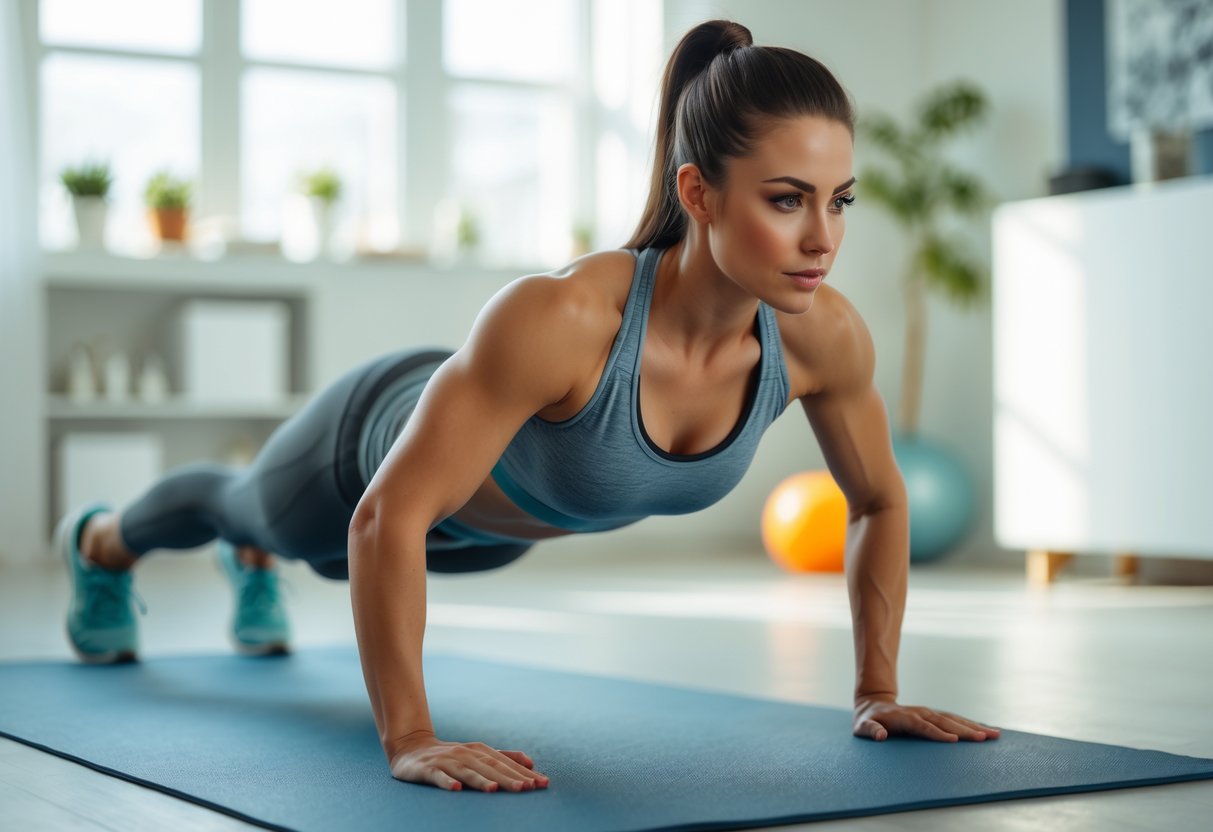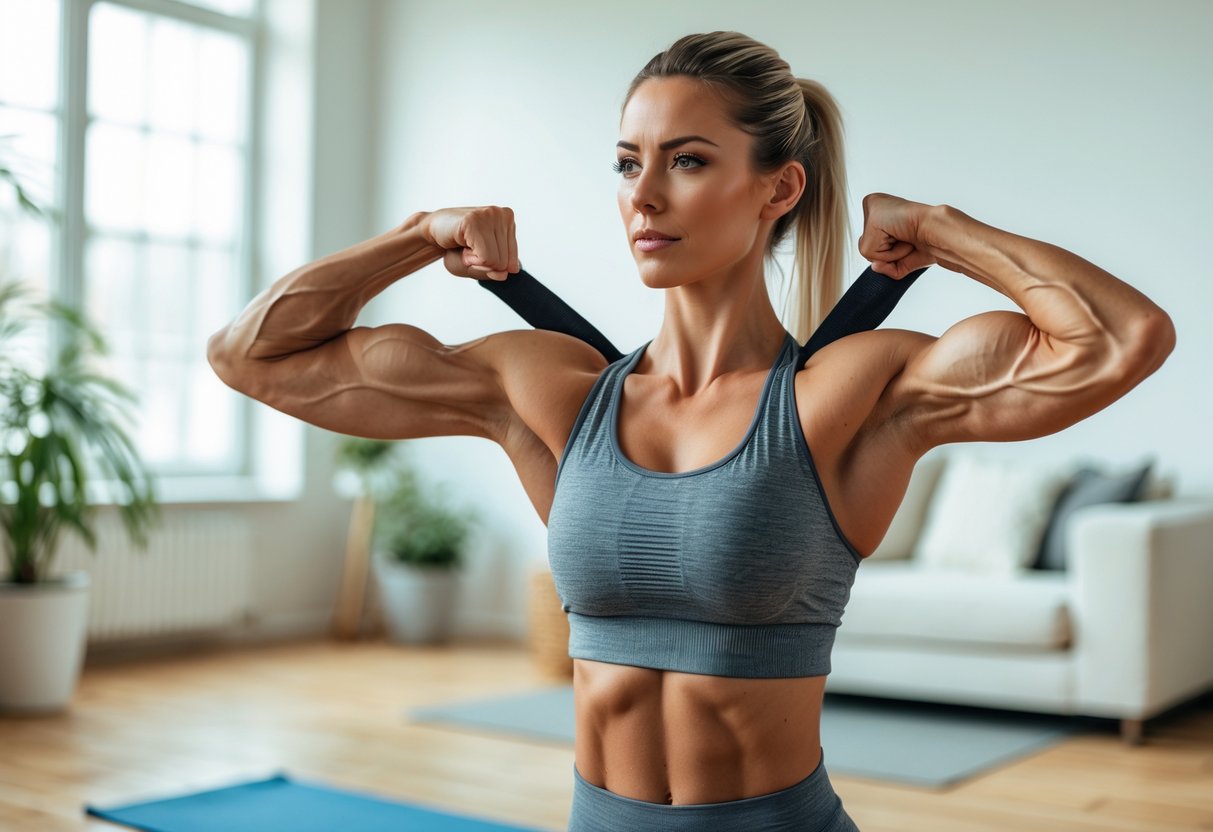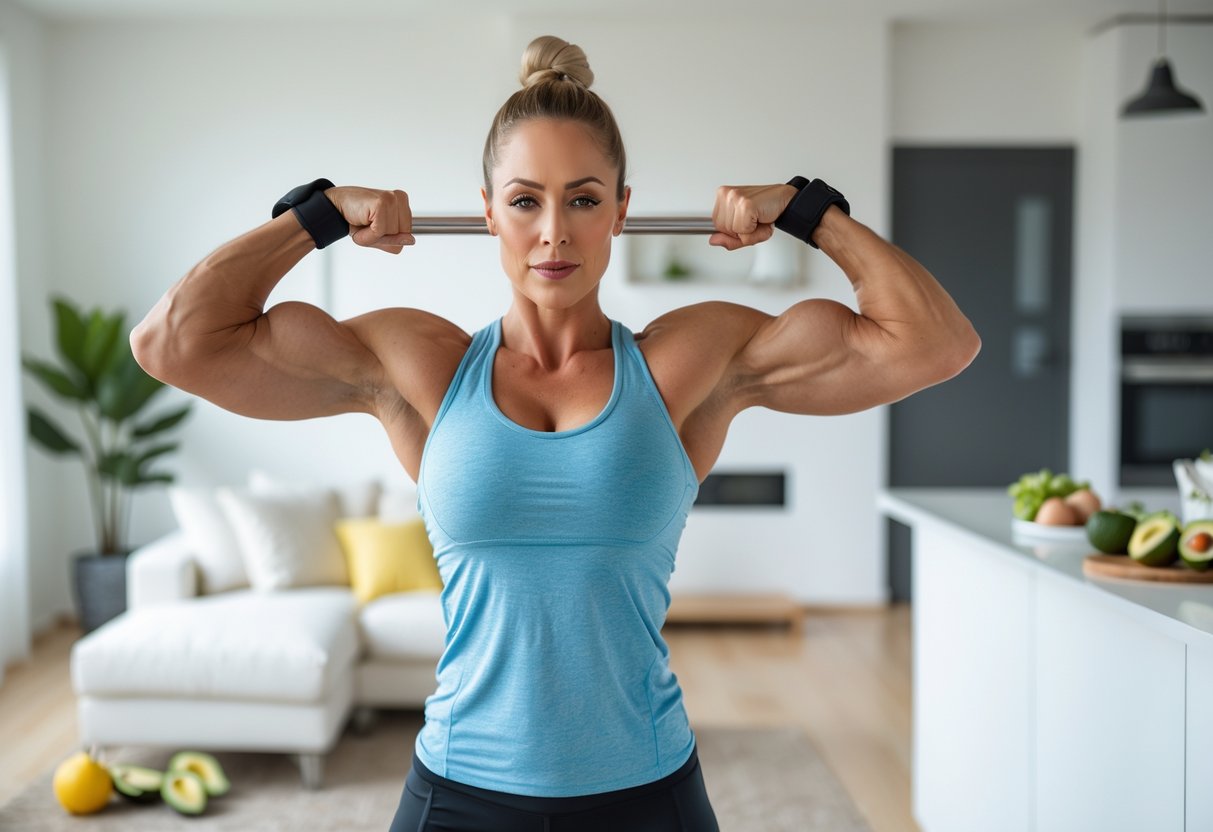Shoulder Home Workout: Build Strength and Mobility Without Equipment, Plus Keto Tips
This post may contain affiliate links. If you purchase through these links, I may earn a small commission at no extra cost to you. LEARN MORE.
Strong, healthy shoulders are important for almost every upper body movement, whether it’s lifting, reaching, or simply carrying daily items.
With the right home workout, people can build stronger, more mobile shoulders without any equipment.
This means anyone can train their shoulders effectively in their own space.
Simple diet tips like keto can support muscle growth.

A well-planned bodyweight shoulder home workout routine covers all parts of the shoulder and helps prevent injuries.
Adding mobility work helps the muscles and joints move better, making training more effective and safer.
If you’re new to bodyweight training, start with our Home Leg Workout for Strength and Fat Loss.
Key Takeaways
- Simple bodyweight exercises can work the whole shoulder.
- Good mobility and smart routines help prevent injuries.
- Keto diet tips can support shoulder muscle growth without extra equipment.
Understanding Shoulder Anatomy and Movement

The shoulder is made up of several muscles and joints that allow the arm to move freely in many directions.
Knowing how these muscles work helps with choosing the right exercises for strength, mobility, and stability.
Deltoid Muscles and Their Roles
The deltoid muscle forms the rounded contour of the shoulder.
It is divided into three main parts:
- Anterior deltoid (front)
- Lateral deltoid (side)
- Posterior deltoid (back)
Each part of the deltoid has a specific job.
The anterior deltoid lifts the arm forward (shoulder flexion).
The lateral deltoid moves the arm out to the side (abduction).
The posterior deltoid pulls the arm backward (extension).
These three heads work together during most shoulder movements, but certain exercises can target each section.
Strong deltoids help with lifting, pushing, and pulling tasks in daily life.
Rotator Cuff Muscles Explained
The rotator cuff is a group of four small muscles wrapped around the top of the upper arm bone.
These muscles are:
- Supraspinatus
- Infraspinatus
- Teres minor
- Subscapularis
Their main job is to hold the shoulder joint together and guide its movement.
They keep the head of the upper arm (humerus) centered in the socket during motion.
Rotator cuff muscles also help with shoulder abduction, rotation, and lifting.
Weakness here can lead to injury or pain, especially over time.
Home workouts focused on control and light resistance can strengthen these important muscles.
Functional Movement and Shoulder Stability
A stable shoulder keeps the joint safe during movement.
Functional movements involve more than muscles; they require control, balance, and coordination.
Activities such as reaching overhead, pushing, or rotating depend on both deltoids and rotator cuff muscles working well together.
Stability comes from a mix of strong muscles and good control of the shoulder blade (scapula).
Practicing shoulder exercises that use slow, controlled actions improves functional movement.
This lowers the risk of injury and supports better performance in activities like sports, lifting, or even daily chores.
Range of Motion and Flexibility
Range of motion refers to how far the shoulder can move in each direction.
The shoulder joint allows a very wide range of movement—more than any other joint in the body.
Flexibility helps with activities that require reaching or lifting.
Limited movement can come from tight muscles, injury, or lack of use.
Key motions include:
- Flexion (lifting arm forward)
- Extension (moving arm backward)
- Abduction (raising arm to the side)
- Rotation (turning the arm inward or outward)
Regular stretching and gentle mobility work can keep the shoulder loose and reduce risk of pain or stiffness.
Stretching the deltoids and rotator cuff muscles is helpful for most people.
Want to burn fat fast? Check out our guide on 15 Minute HIIT Workouts to Burn Fat Fast: Effective Sessions with Keto Fueling Tips.
Bodyweight Shoulder Home Workout

Building strong and mobile shoulders at home requires targeted bodyweight exercises.
Using only body weight, anyone can work multiple muscles in the shoulder, improve stability, and boost shoulder strength without equipment.
Push-Up Variations for Shoulder Strength
Standard push-ups are a simple way to start building shoulder and upper body strength at home.
These work the front part of the shoulders, chest, and triceps.
By changing hand placement or angle, different parts of the shoulders are targeted for balanced strength.
Some effective push-up variations include:
- Wide-grip push-ups – hands placed wider than shoulders to hit more of the deltoids.
- Diamond push-ups – hands together under the chest, working the front delts and triceps.
- Staggered push-ups – one hand forward, one hand back to create instability.
- Archer push-ups – shifting weight from side to side for unilateral strength.
Adding these variations to a home workout routine trains the shoulders from multiple angles and helps prevent muscle imbalances.
Pike Push-Ups and Downward Dog Progressions
Pike push-ups focus strongly on the shoulders by placing the hips high and shifting body weight forward, making the shoulders work harder than in standard push-ups.
This move targets the deltoids, especially the front and middle areas, and also trains the triceps and upper back.
Begin with the body in an inverted “V” shape, feet and hands on the floor, hips raised.
Lower the head toward the ground, elbows out, then push back up.
To progress, work towards the downward dog push-up by bringing the head closer to the mat or raising the feet on a box to increase the range of motion.
Pike push-ups and downward dog progressions are effective alternatives to overhead pressing for building shoulder strength during home workouts.
Need an energy boost before these tough moves? Java Burn can help support metabolism and endurance naturally.
Shoulder Taps for Stability
Shoulder taps are a valuable bodyweight exercise to improve shoulder stability and core control.
Start in a plank or push-up position, then lift one hand to tap the opposite shoulder, alternating sides.
This movement forces the shoulders, chest, and abs to keep the body still while moving one arm at a time.
Shoulder taps can be made easier by widening the feet or harder by bringing the feet close together.
This exercise challenges the body’s ability to resist rotation, promoting balanced development and reducing the risk of injury.
Inverted Rows Without Equipment
Inverted rows usually require a bar, but at home, a sturdy table or broom balanced safely between two chairs can be used.
This exercise targets the rear shoulder muscles (posterior deltoids), upper back, and arms.
It is especially helpful for balancing pressing movements like push-ups and pike push-ups.
To perform an inverted row, lie under the bar or table with feet flat on the floor and grip the edge with hands shoulder-width apart.
Pull the chest up toward the bar or edge, squeezing the shoulder blades together, then lower slowly.
If needed, bend the knees to make it easier or place heels on a raised surface for more challenge.
Inverted rows are an excellent way to include pulling exercises in any shoulder-focused home workout.
Targeting All Shoulder Regions Effectively

Focusing on each shoulder region helps improve muscle growth and definition.
Using bodyweight movements, it is possible to challenge the anterior, lateral, and posterior delts with no equipment.
Isolating Anterior, Lateral, and Posterior Delts
The shoulder consists of three main muscles: the anterior deltoid (front), lateral deltoid (side), and posterior deltoid (back/rear delts).
Training these individually helps promote balanced development and reduces injury risk.
Bodyweight exercises like pike push-ups and rear delt rows are useful for this.
Pike push-ups mainly hit the anterior deltoid, while side-lying lateral raises or leaning push-ups can work the lateral deltoid.
For the posterior deltoid, rear delt rows or reverse snow angels on the floor are helpful.
Here is a summary:
| Deltoid Region | Recommended Bodyweight Movement |
|---|---|
| Anterior (Front) | Pike Push-Ups, Forward-Leaning Push-Ups |
| Lateral (Side) | Bodyweight Lateral Raises, Leaning Push-Ups |
| Posterior (Rear) | Rear Delt Rows, Reverse Snow Angels |
Rear Delt Fly and Lateral Raise Alternatives
Without equipment, some traditional moves like rear delt flyes and lateral raises can be replaced with creative bodyweight options.
The rear delt fly can be mimicked by lying face down with arms stretched out and slowly raising them to shoulder height while squeezing the shoulder blades together.
For lateral raises, lying sideways and lifting your arm, or performing standing “T” raises against gravity, can recruit the lateral deltoid.
Another option is pressing the hands firmly against a wall at shoulder height and pushing outward, which also activates the side delts.
Focus on controlled, slow movements for muscle definition.
Add higher repetitions (15–20 per set) to increase the challenge when using only bodyweight.
Front Delts Activation Techniques
Strong front delts are needed for daily pushing movements and balanced upper body strength.
To activate the front delts at home, pike push-ups remain one of the best choices.
Keeping the hips high and shifting most of the weight toward the shoulders strengthens the anterior deltoid.
Forward-leaning push-ups and inclined push-ups with feet on a step or chair place even more stress on the front of the shoulder.
Slow tempo and full range of motion both help achieve better muscle growth.
Holding the bottom position for a second also maximizes anterior deltoid tension without extra equipment.
Learn how Back Home Workouts complement shoulder strength for posture and balance.
Optimizing Shoulder Mobility and Injury Prevention

Improving shoulder health at home means working on flexibility, joint stability, and early recognition of injuries.
A proactive approach helps lower the risk of pain and keeps shoulders strong and mobile.
Stretching for Flexibility and Recovery
Stretching can help maintain range of motion and prevent stiffness from sitting or repetitive movements.
Simple movements like prone arm circles, cross-body shoulder stretches, and gentle overhead reaches can increase flexibility.
These exercises gently move the shoulder joint through its full range, targeting tight areas.
For best results, stretches should be held for 15-30 seconds and repeated 2-3 times per side.
It is important to avoid bouncing during stretches, as this can strain the tissues.
Adding stretches into a warm-up or cool-down can also ease tension in the neck and upper back.
Consistency helps maintain healthier, more flexible shoulders.
Building Joint Stability at Home
Joint stability protects the shoulder from injury, especially during daily tasks or exercise.
Stability-focused exercises can be done at home with no equipment.
Exercises such as plank shoulder taps, wall walks, and the “Y-T-W” drill (lying face-down, lift arms in Y, T, and W shapes) target smaller stabilizer muscles.
Focused control and slow movements are key for activating and strengthening the rotator cuff.
Below is a table of common stability exercises:
| Exercise | Area Targeted | Recommended Reps |
|---|---|---|
| Plank Shoulder Taps | Rotator cuff, core | 10-20 per side |
| Y-T-W Holds | Rear delts, rotator | 5-8 per shape |
| Wall Slides | Scapular muscles | 10-15 reps |
Performing these 2-3 times per week can help prevent injuries by boosting control around the shoulder.
Addressing Common Shoulder Injuries
Recognition and early care are crucial when dealing with shoulder injuries.
Common injuries include rotator cuff strains, impingement, and tendinitis.
These often show up as pain while reaching, reduced mobility, or a dull ache in the shoulder.
Rest and gentle movement can help manage mild discomfort.
Avoid overhead lifting or repetitive motion if pain is present.
Apply ice during the first 24-48 hours if there is swelling.
If severe pain, instability, or loss of function occurs, they should seek medical advice.
Support faster healing with Nagano Tonic — a powerful formula for inflammation and joint recovery.
Keto Diet Tips for Shoulder Muscle Growth

Eating a ketogenic diet can support muscle growth if nutrition is managed carefully.
Strength training at home often needs a few changes in daily eating habits to help recovery and muscle building.
Adapting Nutrition for Strength Training
Training shoulders at home puts stress on the muscles.
To support growth, it is important to get enough protein and healthy fats while keeping carbs low.
On keto, carbs are limited—usually under 50 grams per day—so the body uses fat for fuel.
When doing strength training, protein helps repair and build muscle fibers.
Keto beginners may need to slightly increase their protein, aiming for about 1.6 to 2.2 grams of protein per kilogram of body weight each day.
Good protein sources include eggs, chicken, fish, and full-fat dairy.
Hydration matters more than many think.
On keto, the body loses more water and electrolytes.
Drinking water and adding foods high in magnesium, potassium, and sodium helps prevent cramps and fatigue.
Keto-Friendly Foods for Recovery
Recovery is key after shoulder workouts.
The right foods support muscle repair and reduce soreness.
The best keto foods for muscle recovery are:
- Oily fish (salmon, mackerel): High in omega-3s and protein
- Eggs: Complete protein and important vitamins
- Avocado: Potassium, healthy fat, and fiber
- Nuts and seeds: Magnesium and healthy fats
- Greek yogurt (unsweetened, full-fat): Supports muscle repair, provides calcium
A post-workout meal might be grilled chicken with leafy greens and avocado or tuna salad with olive oil.
Smoothies made with leafy greens, avocado, and protein powder (no added sugar) are also a good option.
Avoid high-carb foods like bread or pasta, as these can break ketosis.
Check out our Ultimate Keto Food List for more information.
Balancing Energy and Protein Intake
Energy balance is important for muscle growth.
Eating too few calories can slow muscle building and recovery.
On keto, the main source of energy is fat, so meals should include foods like olive oil, fatty fish, nuts, and cheese.
Sample energy sources and protein options:
| Food | Protein (g) | Fat (g) | Carbs (g) |
|---|---|---|---|
| Chicken breast | 24 | 2 | 0 |
| Salmon | 22 | 12 | 0 |
| Eggs (2 large) | 12 | 10 | 2 |
| Almonds (28g) | 6 | 14 | 2 |
Each meal should be balanced with enough protein for muscle repair and enough fat for energy.
If someone feels tired or sore for days, they may need to increase calorie intake slightly.
Tracking meals and using a food scale can help keep macros in line, making muscle growth on keto easier to manage.
Want a personalized eating plan for fat loss and lean muscle? Start your Custom Keto Diet.
Structuring Your Shoulder Workout Routine

Creating a solid shoulder workout routine at home helps improve strength, mobility, and appearance.
A good plan covers how often to train, the kinds of moves to focus on, and practical ways to keep getting stronger.
Building a Weekly Training Plan
Aim to train shoulders 2–3 times per week for best results.
Rest at least one day between sessions to allow muscles time to recover and grow.
A home shoulder workout can include moves like:
- Pike push-ups
- Bodyweight lateral raises
- Rear delt rows (using a towel or doorway)
- Arm circles
Mix these exercises each session.
Perform 3–4 sets of each, with 8–15 reps per set.
Change the order sometimes or add variations for better overall muscle work.
Add shoulder training to a full-body or upper-body workout schedule.
This keeps the rest of the body balanced and avoids overuse.
Progression and Overload Without Equipment
Progression is key for muscle growth, even without weights.
Gradually make your workout harder by tweaking a few variables:
- Increase reps or sets
- Slow down each rep to increase time under tension
- Use single-arm exercises for more resistance
- Take shorter rests between sets
Keep a simple progress tracker to log your numbers each week.
For example:
| Week | Pike Push-Ups | Lateral Raises |
|---|---|---|
| 1 | 3 x 8 | 3 x 12 |
| 2 | 4 x 10 | 4 x 15 |
Small, regular changes help the shoulders adapt and grow stronger without needing equipment.
Need a full plan? Pair this with our 4-Week Strength Program for Women including shoulder days.
Frequently Asked Questions
Bodyweight exercises can build strong shoulders, and there are easy ways to get started at home.
These answers highlight how anyone can develop shoulder muscles, protect joints, and see results without using weights.
What are effective bodyweight exercises for shoulder strengthening?
Pike push-ups, push-up variations, handstand holds against a wall, and bodyweight lateral raises all target the shoulder muscles.
Some people also do rear delt rows using a sheet or towel in a doorway.
Each move works specific areas of the shoulders to help boost strength and mobility.
How can beginners start a shoulder workout routine at home?
Beginners should focus on learning proper form for exercises like pike push-ups and incline push-ups.
Starting with fewer reps and sets, such as 2 sets of 8-10 reps, helps prevent injury.
Warming up before each session and resting a day between workouts is important for progress.
Can you achieve broader shoulders without using weights?
Yes, shoulders can be developed using only bodyweight.
Moves like push-ups, bodyweight lateral raises, and even handstand holds all challenge the shoulders and can help improve size and appearance over time, especially if done regularly with proper technique.
What are suitable shoulder workouts for women at home?
Women can use the same exercises as men, such as pike push-ups, bodyweight shoulder presses, and doorway rear delt flies.
These movements offer functional strength without requiring any equipment.
High-rep, low-impact options are also available for those looking to avoid joint strain.
How can I increase shoulder muscle mass with no equipment?
Consistent training with exercises that target all parts of the shoulder helps build muscle.
Increasing sets, reps, or difficulty, such as elevating feet during pike push-ups, encourages growth.
Eating enough protein and healthy fats, including those from keto-friendly foods, also supports muscle gain.
What strategies can help protect and strengthen weak shoulders?
Gradual progression and focusing on slow, controlled movements can keep shoulders safe.
Strengthening the muscles around the shoulder joint and including mobility drills, like arm circles and band pull-aparts if bands are available, can improve stability and lower injury risk.
Always listen to the body and stop if pain occurs.
Conclusion
Strong shoulders help with everyday movement and reduce the risk of injury.
Bodyweight exercises, like pike push-ups, arm circles, and rear delt flys, build muscle and improve shoulder stability at home.
A simple routine can look like this:
| Exercise | Sets | Reps |
|---|---|---|
| Pike Push-Ups | 4 | 8-12 |
| Bodyweight Lateral Raises | 4 | 10-15 |
| Rear Delt Row | 3 | 10-15 |
| Arm Circles | 2 | 30 seconds |
Training regularly supports both strength and flexibility.
Practicing a variety of movements targets different parts of the shoulder.
Staying on a keto diet may help maintain energy levels during workouts.
A focus on healthy fats and protein supports muscle repair and growth.
Ready to combine targeted workouts with rapid fat loss? Start your Custom Keto Diet now or boost your burn with Java Burn or Nagano Tonic.
